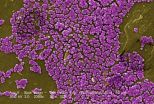(Press-News.org) PROVIDENCE, R.I. [Brown University] — Hepatocellular carcinoma is the most common cancer to strike the liver. More than 500,000 people worldwide, concentrated in sub-Saharan Africa and Southeast Asia, are diagnosed with it yearly. Most of those afflicted die within six months.
A big obstacle to treatment of liver cancer is the lack of early diagnosis. Current techniques, including ultrasound, CT and MRI scans, spot tumors only when they have grown to about 5 centimeters in diameter. By that time, the cancer is especially aggressive, resisting chemotherapy and difficult to remove surgically.
Now a research team led by Brown University reports some promising results for earlier diagnosis. In lab tests, the team used gold nanoparticles ringed by a charged polymer coating and an X-ray scatter imaging technique to spot tumor-like masses as small as 5 millimeters. The approach, detailed in the American Chemical Society journal Nano Letters, marks the first time that metal nanoparticles have been used as agents to enhance X-ray scattering signals to image tumor-like masses.
"What we're doing is not a screening method," said Christoph Rose-Petruck, professor of chemistry at Brown University and corresponding author on the paper. "But in a routine exam, with people who have risk factors, such as certain types of hepatitis, we can use this technique to see a tumor that is just a few millimeters in diameter, which, in terms of size, is a factor of 10 smaller."
The team took gold nanoparticles of 10 and 50 nanometers in diameter and ringed them with a pair of 1-nanometer polyelectrolyte coatings. The coating gave the nanoparticles a charge, which increased the chances that they would be engulfed by the cancerous cells. Once engulfed, the team used X-ray scatter imaging to detect the gold nanoparticles within the malignant cells. In lab tests, the nontoxic gold nanoparticles made up just 0.0006 percent of the cell's volume, yet the nanoparticles had enough critical mass to be detected by the X-ray scatter imaging device.
"We have shown that even with these small numbers, we can distinguish these [tumor] cells," Rose-Petruck said.
The next step for the researchers is on the clinical side. Beginning this summer, the group will attach a cancer-targeting antibody to the nanoparticle vehicle to search for liver tumors in mice. The antibody that will be used was developed by Jack Wands, director of the Liver Research Center at Rhode Island Hospital and professor of medical science at the Warren Alpert Medical School of Brown University.
"We have developed a monoclonal antibody that targets a cell surface protein highly expressed on liver cancer cells," Wands said. "We plan to couple the antibody to the gold nanoparticles in an attempt to detect the growth of early tumors in the liver by X-ray imaging."
The researchers say the X-ray scatter imaging method could be used to detect nanoparticle assemblies in other organs. "The idea should be that if you can figure out to get that [nanoparticle] to specific sites in the body, you can figure out how to image it," said Danielle Rand, a second-year graduate student in chemistry and the first author on the paper.
INFORMATION:
Contributing authors include Yanan Liu from Brown, Wands, Zoltan Derdak and Vivian Ortiz from the Liver Research Center, and Milan Taticek at the Czech Technical University in Prague.
The National Institutes of Health and the U.S. Department of Energy funded the research. Rand's work was supported by the U.S. Department of Education through the Graduate Assistance in Areas of National Need (GAANN) fellowship, administered by the Institute for Molecular and Nanoscale Innovation at Brown.
Gold nanoparticles help earlier diagnosis of liver cancer
2011-06-23
ELSE PRESS RELEASES FROM THIS DATE:
Plant growth rate, stem length unaffected by rice hull, peat substrate
2011-06-23
WEST LAFAYETTE, IN—Plant growth retardants, or PGRs, are used in greenhouse operations to produce uniform, compact, and marketable plants. Although PGRs can be applied using a variety of methods, most common applications are foliar sprays or substrate "drenches". Research has shown that drenches provide more uniform results and increase the duration of effectiveness compared with sprays, but the efficacy of drenches can be affected by factors such as the amount of solution applied and the substrate components used.
Organic components such as parboiled rice hulls are becoming ...
Pest preferences for cranberry cultivars determined
2011-06-23
EAST WAREHAM, MA—Cranberry is an important commercial crop in states such as Massachusetts, Wisconsin, New Jersey, Washington, and Oregon. Insects and disease can pose serious problems for growers trying to realize profits in heavy cranberry production regions. Since cranberry is a perennial crop, pest damage can have a particularly significant negative impact in the next growing season.
By studying feeding preferences of insects, entomologists have reported that several insects prefer some cranberry cultivars over others. For instance, several insect herbivores have ...
Optimal topdressing applications for athletic fields determined
2011-06-23
EAST LANSING, MI—The practice of "topdressing" athletic fields with sand has been used by turfgrass professionals for years. Topdressing is essential to maintaining safe and healthy turf, and using porous sand allows the turfgrass system to retain the necessary pore space for adequate drainage, even in heavy foot traffic.
While sand-based athletic fields may be preferred by schools and municipalities, conversion to a sand-based system is expensive. Complete renovation is often cost-prohibitive and renders the field temporarily unusable. Because of these drawbacks, complete ...
Angioplasty with stents may be safe in long-term for low-risk heart patients
2011-06-23
Heart bypass surgery is considered the gold standard for most patients with left main coronary artery disease, one of the most serious types of heart disease and one that affects thousands.
But a new UCLA study reports favorable long-term outcomes for lower-risk patients with this condition who underwent angioplasty with medication-coated stents, rather than bypass surgery.
A more minimally invasive procedure than surgery, angioplasty is performed by snaking a tiny wire up through an artery in the groin to the blocked area of the heart. The clogged artery is cleaned ...
Slowing the spread of drug-resistant diseases is goal of new research area
2011-06-23
In the war between drugs and drug-resistant diseases, is the current strategy for medicating patients giving many drug-resistant diseases a big competitive advantage?, asks a research paper that will be published in the Proceedings of the National Academy of Sciences. The paper argues for new research efforts to discover effective ways for managing the evolution and slowing the spread of drug-resistant disease organisms. The ultimate goal of this new research effort is to develop a new science-based model for drug-resistance management that will inform treatment guidelines ...
Salamon & Seaber Tests Confirm that URALCHEM's Methods of Fertilizer Analysis Compare with Those of EC Regulation Methods
2011-06-23
URALCHEM, OJSC announces the successful completion of round robin tests of the company's fertilizer carried out by Salamon & Seaber, one of the leading UK analytical laboratories, with the participation of URALCHEM specialists. The main objective of the product sample analysis was to compare the results obtained by applying the methods used in URALCHEM laboratories for quality control to those used by Salamon & Seaber. The test results have proved that the methods certified by Rosstandard (the Russian Federal Agency for Technical Regulation and Metrology) for the ...
Artificial light quality affects herbivore preference for seedlings
2011-06-23
OSAKA, JAPAN—In horticultural production, growers often depend on systems that use artificial light to produce high-quality transplants. Although the systems are efficient, fluorescent lamps can produce plants with shorter shoots than those grown under natural light. Studies have indicated that this reduced shoot elongation is due to the high red:far red ratio of typical commercial fluorescent lamps, which emit little far red irradiation.
In natural environments a reduction in the red:far red (R:FR) ratio resulting from the absorption of red light by neighboring vegetation ...
Early-season strawberry tested in high elevation conditions
2011-06-23
LOGAN, UT—In response to increased awareness generated by the expanding local foods movement, demand for fresh strawberries has increased throughout the United States. The fresh market strawberry industry in the U.S. flourishes in California and Florida—states with ideal weather conditions and long growing seasons. Even with challenging growing conditions, small-scale strawberry production operations succeed in other areas of the country, particularly near urban areas where local produce commands premium prices at market.
Ideal growing conditions for strawberries occur ...
Anelli Xavier Announces Albany, New York, Office Location
2011-06-23
Tom Anelli, known as The DWI Guy, and his team of drunk driving defense attorneys at Anelli Xavier announce the opening of their Albany, New York, law office at the following address:
Anelli Xavier, PC
90 Swan Street
Albany, NY 10027
Map and directions
While the law firm continues to represent clients throughout the state of New York, this expansion allows the firm's attorneys more flexibility in meeting with its Albany DWI clients.
The law firm also upgraded and moved its Syracuse location to:
Anelli Xavier, PC
269 W. Jefferson Street, 2nd Floor
Syracuse, ...
Researchers clock the speed of brain signals
2011-06-23
NEW YORK (June 22, 2011) -- Two studies featuring research from Weill Cornell Medical College have uncovered surprising details about the complex process that leads to the flow of neurotransmitters between brain neurons -- a dance of chemical messages so delicate that missteps often lead to neurological dysfunction.
A recent Nature Neuroscience study led by Dr. Timothy Ryan, professor of biochemistry at Weill Cornell Medical College, demonstrates that individual neurons somehow control the speed by which they recycle synaptic vesicles that store neurotransmitters before ...



